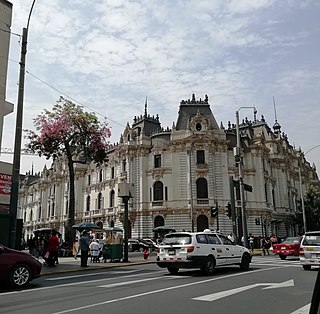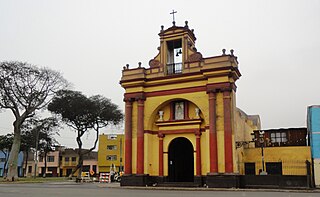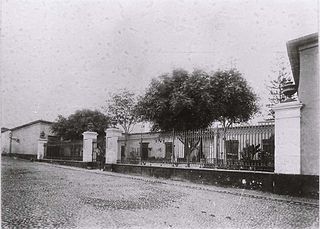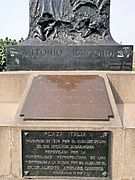
The Walls of Lima were a fortification consisting mainly of walls and bastions whose purpose was to defend the city of Lima from exterior attacks. It was built between 1684 and 1687, during the Viceroy Melchor de Navarra y Rocafull 's government.

Lima is a district of Lima Province in Peru. Lima district is the oldest in Lima Province and as such, vestiges of the city's colonial era remain today in the historic centre of Lima, which was declared a UNESCO World Heritage Site in 1988 and contains the foundational area known as Cercado de Lima.

The Historic Centre of Lima is the historic city centre of the city of Lima, the capital of Peru. Located in the city's districts of Lima and Rímac, both in the Rímac Valley, it consists of two areas: the first is the Monumental Zone established by the Peruvian government in 1972, and the second one—contained within the first one—is the World Heritage Site established by UNESCO in 1988, whose buildings are marked with the organisation's black-and-white shield.

Antonio Raimondi was an Italian-born Peruvian geographer and scientist. Born in Milan, Raimondi emigrated to Peru, arriving on July 28, 1850, at the port of Callao. In 1851 he became a professor of natural history. In 1856, he was one of the founding professors of the medical school at the National University of San Marcos; in 1861, he founded the analytical chemistry department.

Yanahuara District is a suburb within the city of Arequipa, Peru. Yanahuara is well known for its buildings built from sillar, a pearly white volcanic rock. At least 1/4 of the district's area is taken by "Umacollo", where various middle-class residential houses of the city are located. Yanahuara includes the popular avenue strip known as the "Avenida Ejército", where many banks and modern offices are also located. Its surroundings contain various well-cared churches of the Spanish-colonial era, as well as public parks and the well-known "el mirador e iglesia de Yanahuara", a popular spot where tourists concur to view the city and its background volcanoes.

Italian Peruvians are Peruvian-born citizens who are fully or partially of Italian descent, whose ancestors were Italians who emigrated to Peru during the Italian diaspora, or Italian-born people in Peru. Among European Peruvians, Italians were the second largest group of immigrants to settle in the country. Italian immigration in Peru began in the colonial era, during the Spanish Viceroyalty of Peru.

The Jirón de la Unión, or Union Street, is a pedestrian street located in the Historic Centre of Lima, part of the capital of Peru. For many decades it was the most important boulevards of the city, often described as the most aristocratic, where many of the most affluent citizens of the city and most powerful men around the world would meet. Subsequently, with the deterioration of the center of Lima, the Jirón de la Unión lost its aristocratic character and became completely commercialized.

The Plaza Mayor de Lima, or Plaza de Armas de Lima, is considered one of the birthplaces of the city of Lima, as well as the core of the city. Located in the Historic Centre of Lima, it is surrounded by the Government Palace, Lima Metropolitan Cathedral, Archbishop's Palace of Lima, the Municipal Palace, and the Palacio de la Unión.

The Legislative Palace is a government building that serves as the seat of the Congress of Peru, the legislative branch of the Peruvian government. Located at Ayacucho street, it lies next to next to the Bolivar Square and forms part of the neighbourhood of Barrios Altos, itself part of the historic centre of Lima.

Bolívar Square, also known as Congress Square or Inquisition Square, is a public square located at the second block of Abancay avenue, in the neighbourhood of Barrios Altos, in Lima, Peru. Located three blocks east of the city's main square, it forms part of the city's historic centre. Its other names come from the Legislative Palace, which serves as the seat of the Congress of Peru, and the Former Tribunal of the Inquisition, which once housed both the tribunal and the senate, currently functioning as a museum.

Barrios Altos is a Peruvian neighbourhood that forms the eastern part of Lima District, part of the historic centre of the city. It owes its name to the fact that, topographically, it is higher than the rest of the old part of the City, due to the elevation of the land that exists towards the Andes mountain range, which is evident in its streets to this day.

The Basilica and Priory of Nuestra Señora de la Merced is a Roman Catholic church located in Lima, Peru. It was designed in the Baroque style known as Churrigueresque. The church was built under the supervision of Friar Miguel de Orenes in 1535. The Blessed Virgin Mary of Mercy, the patroness of the Peruvian Armed Forces, is venerated in the Basilica. The Mercedarians, who evangelized the region, helped to develop Lima by building many of the churches preserved today.

The Quinta Heeren, formerly known as the Quinta del Carmen, is one of the first private residence condominiums built in Lima around the 1880s.

The Plazoleta de la Merced, also known as the Plazuela de la Merced, is a public square located in front of the Basilica and Convent of Nuestra Señora de la Merced, at the fifth block of the Jirón de la Unión and its intersection with the Jirón Huancavelica, in the historic centre of Lima, Peru.

The Church and Convent of the Good Death, also known as the Church of Saint Camillus, after the order's founder, is a Catholic church and convent in the colonial area of the neighbourhood of Barrios Altos in Lima, Peru. The current temple was built at the end of the 19th century and is dedicated to Our Lady of the Good Death. It is located at the crossroads of the Áncash and Paruro streets, and is diagonal to the Trinitarian Church of Lima.

The Church and Convent of Our Lady of Peñafrancia, better known as St. Clare's Monastery, is a Catholic church, convent and monastery belonging to the Capuchin Poor Clares located in the neighbourhood of Barrios Altos, part of the historic centre of Lima, Peru.

The Church of the Holy Christ of Wonders is a Catholic church located at the junction of Jirón Áncash and Sebastián Lorente Avenue. Located in the neighbourhood of Barrios Altos. It is part of the historic centre of Lima, Peru. It is named after the devotion of the same name.

The Hospital Civil de la Misericordia, also known as the Hospicio de Insanos or Manicomio del Cercado, was a mental institution that operated in the former Quinta Cortés of the neighbourhood of Barrios Altos, in Lima, Peru, between the years 1859 and 1918. A Civil Guard training school was inaugurated on the former hospital's premises after its closure, which is currently used by the National Police of Peru.

The Museum of Congress and the Inquisition, also known as the Monumental Museum of the Inquisition and Congress, is a museum located at the former headquarters of the Tribunal of the Holy Office of the Inquisition in the neighbourhood of Barrios Altos, part of the historic centre of Lima, Peru. Located at the fifth block of Jirón Junín, next to the Plaza Bolívar, it is dedicated to the histories of both the Tribunal and the Congress of Peru.

The Church of Saint Anne is a Catholic church that forms part of the historic centre of Lima, Peru. It is located in Barrios Altos, next to Italy Square, and is one of two main candidates for the location of Rímac, the Indian oracle that gave the local river—and thus the city—its name. For this reason, the site receives the name of Huaca de Santa Ana.





























